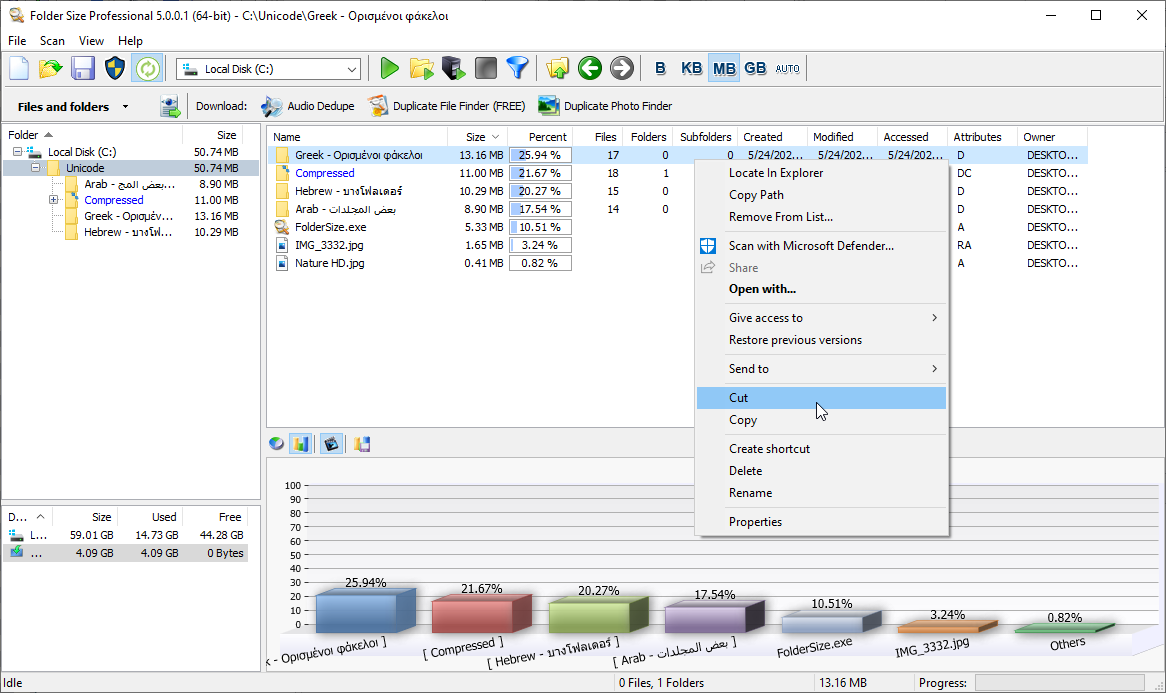Folder Size explorer will show all folder sizes in Windows. Find the largest files and largest folders. Print folder tree and files list, export folders and files to excel, and much more.
Folder Size Explorer 5.2.0.1
In the previous version, we provided Cut, Copy, Paste, and Rename features. Those are accessible via the context menu in the application by clicking the right mouse button on a folder or file. You can use them both inside the application and also in Windows Explorer. That is to say, you can copy files and folders in Windows Explorer and then paste them into the Folder Size application and vice versa.
In this new release, we provide all the corresponding keyboard shortcuts for those actions.
- Cut – CTRL+X
- Copy – CTRL+C or CTRL+INS
- Paste – CTRL+V or SHIFT+INS
- Delete to Recycle Bin – DEL
- Delete permanently – SHIFT+DEL
- Properties – ALT+ENTER
- Rename – F2
The above shortcuts are the same as the ones in Windows File Explorer. As already noted you can use them in Folder Size as if it was a Windows Explorer window. For example, you can select files in the application and press CTRL+X to cut them. Then you can switch to Windows Explorer and press CTRL+V to move the files to the currently displayed folder.
We have replaced the delete functionality in this new release. Folder Size used all native Windows delete features, but this release uses the Windows File Explorer delete functionality. This provides better compatibility as deleting files in the application is now exactly the same as deleting them in File Explorer.
If you invoke the cut action the tool will display the cut files in a slightly lighter gray color in the files list. This new version displays the cut folders in the folders list in a lighter color too.
Folder Sizes In Windows 11, 10, 8, 7 Explorer
While it would be great if Windows Explorer could show folder sizes, such a feature would have a huge negative performance impact on your system. Certainly, that is not worth it for a feature that you would rarely need. We have covered all the issues related to having the folder sizes listed in Windows Explorer.
There were tools that displayed the folder sizes in Windows XP File Explorer, but such tools caused the same slow-downs that Windows itself would have if natively provided the feature. That is why Microsoft no longer allows such tools to integrate into Windows Explorer. Starting from Windows Vista Microsoft removed the API that allowed modifications to File Explorer.
Unfortunately, the tools that used those APIs now display a popup window near the File Explorer displaying the folder size. Even if we ignore the fact that such a popup is inconvenient and annoying, such tools still cause the same slow-downs to a system. The reason for that is because they install services or copy hooks. This means that such tools work in the background regardless if you use them or not.
File and Folder Monitoring Services and Copy Hooks
In order to understand why you should avoid tools that use services and copy hooks, you should know what those technologies do.
A service is a type of application that has no user interface. It starts when Windows starts and works in the background all the time. In the case of folder analysis tools, such a service collects information about every file operation. The tools that install such service then query the service for the folder sizes when you start the user interface. It may seem that those tools are fast and show the folder sizes instantly when started. In reality that is not true – part of those applications is slowing down your system all the time as it is running in the background as a service.
Another approach that many tools use is the copy hooks. Installing copy hooks could be even worse than using a service. This is because Windows calls a function from the application that installed the hook on every file operation. Even the slightest delay in such a function has a huge impact on the file system performance. This is because hundreds of file operations are performed on your system in the background.
Show Folder Sizes Instantly
Folder Size does not install any services or copy hooks. It has ZERO impact on the performance of your system. Nevertheless, it will detect all file and folder changes and view them immediately. This means that you do not need to scan the folders again if you have copied or deleted files in the scanned locations.
If you want to show folder sizes instantly just start the application and scan the folders or drives that you are interested in. You can then minimize the application while you are not using it. If you move, delete, or copy files in the scanned locations using Windows Explorer, the tool will automatically update itself.
If you do not want Folder Size to run all the time you can simply use the File Explorer context menu “Scan with Folder Size”. Just right-click a folder or drive and select the item from the popup menu. Scanning fast SSD drives takes just a few seconds.
You can find all the new features of Folder Size on the What’s new page.
Please share this article with your friends – they will thank you!



